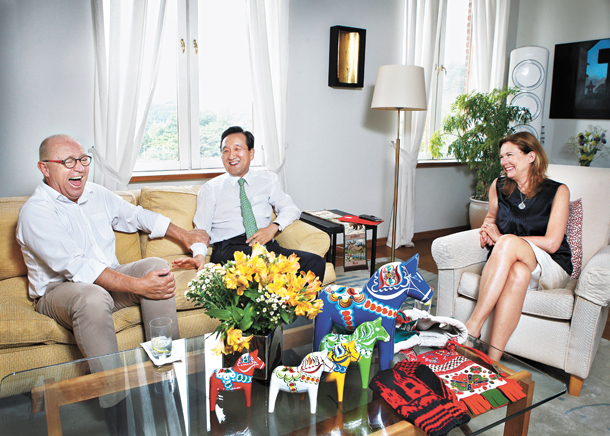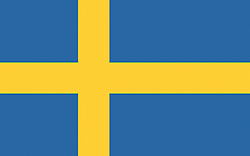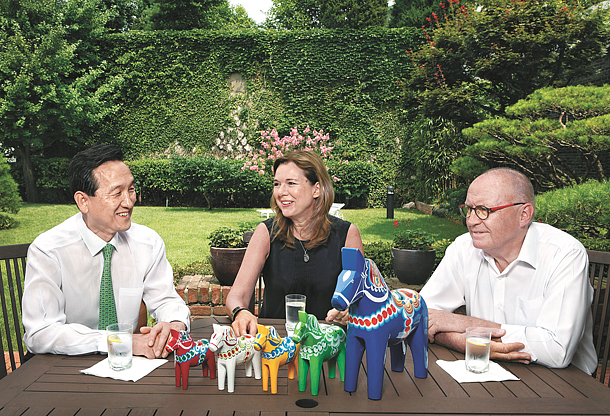[TRADING PLACES] Swedish solutions find a keen audience in Korea

From left, Roland Idemyr, a Swede in his fourth year in Korea after retiring from 26 years of work at IKEA, Son Sung-hwan, former Korean ambassador to Sweden, and Swedish Ambassador to Korea Anne Hoglund enjoy hearty conversation in the living room of her residence in central Seoul on July 13, surrounded by goods from Sweden, including Dala horses, painted wooden horse figures, and traditional Swedish clothing. [PARK SANG-MOON]
Roland Idemyr: I am a mentor to 13 Koreans, all aged between 25 and 40. They have been my source to understand this country. I mean we have talked about everything from the military system, school system, and political system - everything. It is fantastic here. So, I am so thankful for them.
One particular mentee left a rather strong impression on Idemyr.

Idemyr: One day she called me and she was crying. She said she had run away from home and had stayed one night with a friend, but that she couldn’t stay there anymore. She told me, “I’m not going to meet you anymore because now I have decided to take my life.” So my wife and I invited her to our home and she stayed three weeks with us. When she had recovered a little and was ready to meet her family again, she did that and she left. She is working these days and it’s great to see that she has her own life.
On another occasion, Idemyr helped a Korean adoptee find her way back to where she was born. In 2002, Korea was the second-largest source of adoptees in Sweden.
Idemyr: The first summer I was back in Sweden after I had moved here, I met a Korean woman. I had been an officer in the Swedish army before I joined IKEA, and we had some kind of gathering in my old regiment. The woman was in charge of a restaurant and she told me she was from Korea and that she came to Sweden when she was 10 months old. All she knew was that she was born in Daegu. She was in her 40s then and she said she had never been back because she had heard rumors that adopted kids were not welcome in Korea. But my knowledge after my very short time here was the opposite. So I told her that to take the opportunity to go when she can because she would be welcomed. She has been to Korea four times now, going every year with her family. I think a lot of the adoptees want to explore their roots.
Anne Hoglund: Yeah, we have many coming, returning in big groups. Their visits are arranged by the Swedish adoption center. I met a group recently. They come with their families and I’ve also attended wedding ceremonies of Korean adoptees coming back as adults to get married here.
Idemyr is also an adoptive parent.
Idemyr: When my ex-wife and I first met, we were very young. She was only 16 and I was 21. And after some years we had decided to live together and later to get married, and both of us wanted to have kids. We talked about it and decided we didn’t care if our kids would be biologically born or adopted. If I remember right, we got three countries to choose from. And we picked India. And the only wish we had was to get a kid as young as possible. And our son, when he came, he was 4 years old. He spoke Hindi when he came, and then we decided that he needed a sibling, so we started the process again, and then we got a little girl, also from India. And she’s six years younger. I was in India and picked her up in New Delhi, and she was 10 months old when I came home with her. And my son is turning 40 this summer and my daughter has just turned 34. Sometimes I feel they are more Swedish than I am.

From left, Son Sung-hwan, Swedish Ambassador Anne Hoglund and Roland Idemyr discuss their experiences in Sweden and in Korea in the garden of the ambassador’s residence in central Seoul last month. [PARK SANG-MOON]
Anne Hoglund’s fascination with Korea and the Asian region is shared widely with her children, who for a period of time chose to study and live in Seoul during their mother’s tenure here.
Hoglund: My daughter was here for autumn last year and has returned. She graduated from university but then she wanted to come to Korea to join us here. So she came and studied Korean, and I think it’s a really good experience for her. She wants to work with Asia in some way and it’s very good to have knowledge about Asia and to have connections and to understand how society is set up in Asia.
Hoglund: My son, when he heard that I was going to Korea, he said, “I want to come with you and I want to study in Korea.” He was 17 when he came and stayed here two years. He graduated high school here and now wants to work first. Both my children, they really love Korea. They love it 100 percent, no complaints. They’re so enthusiastic about Korea, they didn’t want to leave.
When it comes to young adults leaving their homes to lead independent lives, the Swedish may be venturing into independence earlier than many Koreans.
Idemyr: I found this out through many young mentees I have: that young Koreans have difficulties in growing up and becoming adults. They stay too long at home - they are living at home until they’re getting married. We try to get rid of the kids, excuse me, but I think it’s good if the kids move out and live by their own as quick as possible, to take responsibility for their life.
Hoglund: In Stockholm many students try to be independent after school ends and they try to find their own housing. But nowadays it’s so expensive and difficult, especially in Stockholm, to afford your own housing, so sometimes they stay at home longer. But it’s not really good. I agree with Roland because when children grow older they’re already adults. They want to have their own life and they need to have their own life.
Son Sung-hwan: I think one of the differences between Sweden and Korea is that when the Swedish young people go to college or university, they leave their homes, but their social system supports their tuition and other stipends and they can be independent economically. They are not affluent, but they can survive without the support from home.
Hoglund: Education in Sweden is free, and students can apply for grants to cover their living costs. Another point is that we need to let the young people come in and have influence. One statistics I saw said that the average age of officials in government and parliament in Sweden is 45 and here around 60. I mean, all these people are going to make decisions about the lives for the younger generation, and you don’t have young people influencing decisions in parliament, or government. And you see these politicians making decisions. So it’s very important to have young people and those concerned involved.
Hoglund: And the young generation in Korea is so resourceful. They are smart and intelligent people and I think we should use the young people better and have respect for young people.
Idemyr: It’s probably the most well-educated young generation in the world. I can’t find any country to match it. I think around 98 percent of all kids go through university in Korea. It’s amazing.
Hoglund: And also, young people should have more influence in companies, in politics, in everything. Then Korea will be invincible.
Saving waste
If Son recalls one scene from his time in Sweden, it is how much he saw people biking on the roads.
Son: I attended a national holiday reception and the chief protocol officer of the Swedish Foreign Ministry came riding on a bicycle.
Son: Including the members of the Parliament, Swedish people often walk the streets, use public transportation such as buses, trams, and enjoy a lot of eco-friendly bikes. It is easy to spot young mothers who are riding bicycles with their children.
Idemyr: All citizens are becoming more environmentally aware and they are forcing out cars from cities. I’ve seen it a lot in Helsingborg. I came back from Sweden two days ago, and I’ve been in Helsingborg. There’s a lot of work going on where they are making roads for buses and bicycles but only small tiny roads for cars. Which means the signal is very clear: leave your car at home.
Son: I am also aware that one of the Swedish waste management companies is working in Korea and is very successful.
Hoglund: They convert waste into energy, so you can heat houses with this. And there are also biogas stations that run most buses in Stockholm.
Idemyr: Actually these waste power plants in Sweden don’t have enough waste, so they have to buy waste from Germany, and Holland to burn and get energy off it.
Son was the Korean ambassador to Sweden from 2013 to 2017.
When Korean National Assembly members visited the country, their most frequently asked questions were on the welfare and tax system of Sweden, Son said.
Son: They are mostly interested in the Swedish welfare system and tax system. Mostly they try to learn the secret of the Swedish model with a hefty general welfare system and equalities among citizens, and transparency and trust in societies.
Hoglund: All that the government pays is published on internet. You can go on the internet and you can see all the expenses of parliamentarians and government officials - it’s all public.
Son: So what is the level of openness of your government documents?
Hoglund: 100 percent. It’s all open.
Idemyr: And I think this principle also help us to prevent corruption.
BY ESTHER CHUNG [chung.juhee@joongang.co.kr]
Swedish Ambassador Anne Hoglund
Appointed as the ambassador of Sweden to Korea in September 2015, Anne Hoglund was previously ambassador of regional trade promotion and regional trade policy in the Swedish Foreign Ministry’s department for Asia and the Pacific region. She also served as the ambassador to Cambodia from 2010 to 2013 and as vice consul in Barcelona, Spain. Married with three children, the top envoy was also the head of the South Asia division in the department for Asia and the Pacific region and the head of the Southern Africa division in the department for Africa. Hoglund has studied six foreign languages and was once a tour guide in the Canary Islands in Spain before she joined the Swedish Foreign Service in 1990.
Roland Idemyr
In his fourth year in Seoul this year, Roland Idemyr moved to Korea with his wife when she opened the first IKEA store in Seoul. Idemyr worked at IKEA for 26 years but retired when they moved to Seoul. Also the chairman for the Swedish Chamber of Commerce in Korea, Idemyr loves to cook. He is mentoring 13 Koreans aged between 25 and 45, some of whom he says keep in touch even when they go abroad, by way of Skype calls. His two children were adopted from India.
Son Sung-hwan
Formerly the Korean ambassador to Sweden from 2013 to 2017, Son was also the ambassador for climate change for the Korean Foreign Ministry in 2011, consul general in Chicago in 2007, and was also appointed across embassies and consulates in Russia, Geneva, Kazakhstan and New York. Married with one daughter, he is now a visiting professor in the College of Language and Trade at the Hankuk University of Foreign Studies in eastern Seoul.
Our latest series about the diplomatic community in Seoul, “Trading Places,” focuses on the experience of living in a foreign land. In each installment, an ambassador invites to his or her home a compatriot living in Korea and a Korean who lived in the ambassador’s country. They swap memories - good, bad and amusing - and describe how a distant country that was once an abstraction, a colored patch on a map, became a part of their lives.-Ed.










with the Korea JoongAng Daily
To write comments, please log in to one of the accounts.
Standards Board Policy (0/250자)